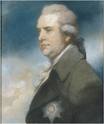|
Lord George Macartney
(1737-1806) was the English ambassador sent to China . The first British
Embassy to China, for the promotion of science and to secure
a more favorable trade agreement and diplomatic ties, set sail from
Spithead on 26 September 1792. The embassy was given the
opportunity of traversing a part of the country beyond the Great
Wall when it travelled in early September 1793 to Jehol, one of the summer residences of the Manchu Emperors.
Macartney, along with visiting Mongols and Burmese, was then given a single imperial audience and presents for his mission and the King. He received no state dinner. Macartney was received only as a tribute bearer. The 85-year-old Emperor Qianlong 's councilors had already prepared a haughtily worded edict. It acknowledged King George III's "sincere humility and obedience" in sending a tribute mission to the Emperor. It also absolutely rejected the proposals for changing the existing trade arrangements since they did not "conform to the Celestial Empire's ceremonial system." This was quite possibly because the Chinese government was alarmed by news of recent great troubles in Europe and considered the inhabitants there to be of a turbulent character, conquering nations by violence and deception. The imperial edict Macartney was to convey to George III declared that China was self-sufficient and had "not the slightest need for your Country's manufactures." It also admonished the British monarch to "act in conformity with our wishes by strengthening your loyalty and swearing perpetual obedience..." After the audience there was the return to Peking in late September. The embassy was allowed to return from the Chinese capital beginning on 7 October to Canton through the interior of China. Reaching Canton on 19 December, the members sojourned in that city and in Macao, leaving there on 17 March 1794 and arriving in England on 6 September. Sir George Leonard Staunton (1737-1801), Secretary to the embassy, brought home from this journey a rare collection of Chinese plants gathered by him in regions where plants had never been collected by Europeans before. The secretary was charged with producing the official account of the Embassy after their return. Some 400 plants are listed with their botanical names in Staunton's three-volume work, An authentic account of an embassy from the King of Great Britain to the Emperor of China ... : Together with a relation of the voyage ... to the Yellow Sea, and Gulf of Pekin ... : Taken chiefly from the papers of ... the Earl of Macartney ... Embassador Extraordinary and Plenipotentiary ... and Sir Erasmus Gower, Commander of the Expedition, and of other gentlemen ... of the Embassy. 1 
An Authentic Account of An Embassy From the King of Great Britain to the Emperor of China (1797):
"The hall of audience furnished also another [53] object of curiosity, striking at least
to strangers. On several tables were placed in frames, filled with earth, dwarf pines, oaks, and orange trees,
bearing fruit. None of them exceeded, in height, two feet. Some of those dwarfs bore all the marks of decay
from age: and upon the surface of the soil were interspersed small heaps of stones, which, in proportion to the adjoining
dwarfs, might be termed rocks. These were honeycombed and moss-grown, as if untouched for ages, which served to
maintain the illusion, and to give an antique appearance to the whole. This kind of stunted vegetation seemed to be
much relished by the curious in China; and specimens of it were to be found in every considerable dwelling [sic]. To produce
them formed a part of the gardner's [sic] skill, and was an art invented in that country. Beside the mere merit of overcoming
a difficulty, it had that of introducing vegetables into common apartments, from which, their natural size must otherwise
have excluded them. According to the usual course of nature, different vegetable productions attain their perfect
state in different periods, and after acquiring different dimensions, and passing through different stages of growth.
Thus the cedar of Lebanon, for example, consumes some years in forming a [54] tall and woody trunk, with many horizontal
branches, before it emits its colourless flowers, and small cones, for the purpose of reproduction, which is the period of
its perfection; while the hyssop, capable, at most, of raising a short herbaceous stem, produces its flowers and seeds the
season after it is sown. Some trees are reproduced, indeed, from cuttings of young branches, without the necessity of
sowing any seed; but such cuttings, planted in the ground, must become trunks themselves in the usual period of their
respective increase, and after acquiring their ordinary size, emit new branches, before they become adult, or capable of
fructification; but by the art of dwarfing, an abscinded branch committed to the earth, continues still to fructify, as
if it had been grafted upon a full grown tree, with its juices ripened for reproduction. |